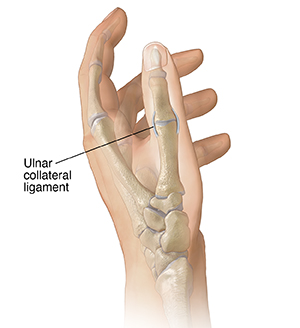Understanding Skier’s Thumb
Skier’s thumb is an injury to the ulnar collateral ligament. This ligament is at the base of the thumb on the side near the pointer (index) finger. It helps keep the thumb stable when grasping or pinching objects. With skier’s thumb, the ligament is stretched or torn (sprained). This can cause pain. It can also limit movement and use of the thumb. Depending on how severe the injury is, it may take a few weeks or longer for the thumb to heal. This injury is also sometimes called gamekeeper's thumb.

Causes of skier’s thumb
Skier’s thumb is most often caused by a fall on an outstretched hand. Skiers tend to get this injury, which is how the condition gets its name. But the injury can also occur as the result of any activity or accident that forces your thumb into an extreme position.
Symptoms of skier’s thumb
Symptoms include pain, swelling, redness, and bruising. These symptoms occur in the thumb, but may spread to the rest of the hand in some cases. The injury can make it hard to hold or grasp things. For instance, holding a pen or glass or turning a doorknob may be difficult.
Treating skier’s thumb
Treatment for skier’s thumb may include any of the following:
-
Prescription or over-the-counter medicines. These help reduce pain and swelling. NSAIDs (nonsteroidal anti-inflammatory drugs) are the most common medicines used. Medicines may be prescribed or bought over the counter. They may be given as pills. Or they may be put on the skin as a gel, cream, or patch.
-
A splint, brace, or cast. This is worn to support your thumb and keep the thumb from moving. It may be needed for a few weeks or longer until the thumb heals.
-
Physical therapy and exercises. These help improve strength and range of motion of the thumb, hand, and wrist, if needed.
-
Surgery. You may need surgery if the ligament is severely stretched or torn, or if nearby tissues and bone are also injured. After surgery, you will need to wear a splint or cast for a month or longer until the injury heals.
Self-care measures
There are things you can do on your own to help relieve pain and swelling:
-
Limit how much you move and use your thumb and hand.
-
Apply an ice pack to the injured area.
-
Keep your hand raised (elevated) above heart level.
-
Wrap your thumb and nearby fingers with special tape or bandages.
Possible complications of skier’s thumb
If the injury doesn’t heal properly, it has a higher chance of happening again. The injury can also become long-term (chronic). This can cause ongoing pain, weakness, or instability of the thumb. Over time, arthritis may develop in the joint at the base of the thumb. This can worsen pain and cause stiffness and limited thumb movement.
When to call your healthcare provider
Call your healthcare provider right away if you have any of these:
-
Fever of 100.4°F (38°C) or higher, or as directed by your provider
-
Chills
-
Symptoms that don’t get better with treatment, or get worse
-
Symptoms such as redness, warmth, swelling, bleeding, or drainage that occur near incision sites—this only applies if you had surgery
-
New symptoms